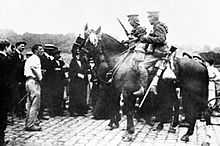18th Royal Hussars
| 18th Royal Hussars (Queen Mary's Own) | |
|---|---|
| Active |
1759–1821 1858–1922 |
| Country |
|
| Branch |
|
| Type | Cavalry |
| Role | Line Cavalry |
| Size | 1 Regiment |
| Nickname |
The Young 15th The Drogheda Light Horse |
| Motto |
Pro rege, pro lege, pro patria conamur (For King, for Law, for Country we strive) |
| Commanders | |
| Notable commanders |
Field Marshal Charles Moore, 1st Marquess of Drogheda |
The 18th Royal Hussars (Queen Mary's Own) was a cavalry regiment of the British Army, first formed in 1759. It saw service for two centuries, before being amalgamated into the 13th/18th Hussars in 1922.
The regiment was first raised as the 19th Regiment of (Light) Dragoons in 1759, renumbered the 18th Regiment of (Light) Dragoons in 1763, and briefly the 4th Regiment of Light Dragoons in 1766 before settling on the 18th in 1769. In 1805 it took the title of the 18th (King's Irish) Regiment of (Light) Dragoons, named for George III, and redesignated as hussars in 1807, becoming the 18th (King's Irish) Regiment of (Light) Dragoons (Hussars). It was informally known as the "Drogheda Light Horse" and it was humorously referred to as the "Drogheda Cossacks". It was disbanded in Ireland in 1821.
The regiment was reformed in 1858, as the 18th Regiment of (Light) Dragoons from a nucleus taken from the 15th Hussars, and renamed the 18th Hussars in 1861. In 1903 it was named the 18th (Princess of Wales's Own) Hussars, for Princess Mary, being retitled the 18th (Victoria Mary, Princess of Wales's Own) Hussars in 1905 and the 18th (Queen Mary's Own) Hussars in 1910 to mark her coronation as Queen Consort. After service in the First World War, the regiment retitled as the 18th (Queen Mary's Own) Royal Hussars in 1919, then the 18th Royal Hussars (Queen Mary's Own) in 1921, and was amalgamated with the 13th Hussars to form the 13th/18th Hussars the following year.
Commanding officers
Colonels
| Name | Appointment |
|---|---|
| Charles, Marquess of Drogheda | 3 Aug. 1762 [1][lower-alpha 1] |
| Edward Byam | 16 Nov. 1858 [1][lower-alpha 2] |
| Sir Charles O'Donnell | 10 Sep. 1864 [3][lower-alpha 3] |
Lieutenant-colonels
| Name | Appointment |
|---|---|
| Richard Georges | 17 June 1761 [3] |
| William Hardcourt | 17 Apr. 1765 [3] |
| Edward Walpole | 25 June 1768 [3] |
| Charles Wilson Lyon | 13 Apr. 1771 [3] |
| Charles W. Vane Stewart | 12 Apr. 1799 [3] |
| Oliver Thomas Jones | 29 Jan. 1801 [3] |
| Henry Murray | 2 Jan. 1812 [3] |
| Richard Knox | 23 Feb. 1858 [3] |
Battle honours
- Peninsula, Waterloo, Defence of Ladysmith, South Africa 1899-1902
- The Great War: Mons, Le Cateau, Retreat from Mons, Marne 1914, Aisne 1914, La Bassée 1914, Messines 1914, Armentières 1914, Ypres 1914 '15, Gravenstafel, St. Julien, Frezenberg, Bellewaarde, Somme 1916 '18, Flers-Courcelette, Arras 1917, Scarpe 1917, Cambrai 1917 '18, St. Quentin, Rosières, Amiens, Albert 1918, Hindenburg Line, Pursuit to Mons, France and Flanders 1914-18
See also

Notes
- ↑ Lord Drogheda entered the British Army, as cornet in the 12th Dragoons on 1 May 1744; was gazetted as Colonel of the 18th Hussars 3 August 1762; and died on 22 of December 1821; having been colonel of the Regiment for sixty-two years.[1]
- ↑ Lieutenant-General Byam served the campaigns of 1812, '13, '14, and '15, including the battles of Salamanca, Vittoria, Orthes, and Waterloo, besides minor affairs. Severely wounded by a grape-shot while carrying the regimental colour of the 38th at Salamanca, and slightly wounded at Waterloo. He has received the War Medal with three Clasps. Major-General Byam's first commission was an ensigncy in the 38th, with which regiment he served two campaigns: all his other commissions and the rest of his service were in the 15th Hussars.[2]
- ↑ Sir Charles O'Donnell was present with the Russian troops in the campaign of 1828 on the Danube against the Turks; and in 1849 with the German troops in Schleswig-Holstein and Jutland, especially at Duppel and the battle of Fredericia.[3]
References
 This article incorporates text from a publication now in the public domain: Malet, Harold Esdaile (1869), Historical records of the Eighteenth Hussars, W. Clowes, pp. 62–63
This article incorporates text from a publication now in the public domain: Malet, Harold Esdaile (1869), Historical records of the Eighteenth Hussars, W. Clowes, pp. 62–63
Further reading
- Mills, T.F., "18th Royal Hussars (Queen Mary's Own)", regiments.org, archived from the original on 18 January 2008, retrieved April 5, 2007 Includes chronological index of titles.